Ultrasonic Fatigue Testing of Structural Steel S275JR+AR with Insights into Corrosion, Mean Stress and Frequency Effects
Abstract
:1. Introduction and Motivation
2. Available Fatigue Data
3. Experimental Procedure
3.1. Ultrasonic Machine
3.2. Tensile Testing
3.3. Heat Generation
3.4. Specimens Manufacturing
3.5. Corrosion Inducement
4. Results and Discussion
4.1. Results Summary
- Data points with a crack originating on the surface;
- Data points with a crack starting from subsurface (s/s);
- Data points for the samples pre-corroded for 2 weeks (p/c 2w);
- Data points for the samples pre-corroded for 1 month (p/c 1m).
4.2. Fatigue Limit
4.3. Strain-Rate Effect
4.4. Corrosion Effect
4.5. Mean Stress Effect
5. Conclusions
- The insights into frequency, environmental and mean stress effects of the fatigue performance are also provided. In order to understand the influence of environment, the fatigue samples were tested in two surface conditions—polished and pre-corroded—for 2 weeks and 1 month. In order to reach a few billion cycles within a practically sustainable testing time, an accelerated fatigue testing is required. The goal of reaching gigacycle fatigue domain is achieved using the ultrasonic fatigue testing approach with the Shimadzu USF-2000A system, which runs at 20 kHz of resonance frequency.
- Confidence and competence in running ultrasonic fatigue tests have been obtained by overcoming multiple technical challenges. The duration of fatigue tests has been extended to reach 10 billion cycles in less than 10 days by modifying the forced cooling using a standard cooling hose with an additional cold-air gun able to reduce the temperature by 45 °C. However, this modification has introduced the instability of the cold air flow rate with unpredictable temperature fluctuation. The developed LabView fixed this issue. The program reads the temperature from the infrared PyroCube thermometer and initiates an emergency test stopping when temperature increases over 30 °C.
- Pronounced strain rate effect is a big challenge for the determination of SN curves with accelerated fatigue testing: particularly, the fatigue limit that strongly depends on the frequency of testing. Testing at 20 kHz using ultrasonic machines significantly exaggerates fatigue strength compared to normal loading conditions. For S275JR+AR steel grade, the quantitative difference between SN curves obtained at 15 Hz and 20 kHz was measured in terms of stress amplitude as 167.7 MPa on average.
- Basic quantification of the frequency effect contribution has been done using the estimated difference in stress amplitude between the high-frequency and low-frequency SN curves. A simple extrapolation/down-scaling of the ultrasonic fatigue testing results in a low-frequency domain that can be applied to the obtained data from pre-corroded samples. Consideration of the continuously progressing corrosion damage using pre-corroded batches of samples brings the extrapolated design stresses at 10 billion cycles to low and alarming values, which are still subject to validation.
- The fracture surfaces are investigated using both using optical stereo-microscopy and SEM microscopy. The advantage of the first method is that it can capture surface colouring that helps to understand the history of the crack propagation. The disadvantages are uneven focus and variable resolution quality for the whole fracture surface images. On the other hand, second method produces a perfect resolution images of the whole fracture surface, but colour information is completely lost.
- Finally, this research work has considered two mean stress correction methods—Walker and FKM. Both demonstrated a very similar effect on the available fatigue data extrapolation capability.
Author Contributions
Funding
Institutional Review Board Statement
Informed Consent Statement
Data Availability Statement
Acknowledgments
Conflicts of Interest
References
- EN 10025-2; Hot Rolled Products of Structural Steels—Part 2: Technical Delivery Conditions for Non-Alloy Structural Steels. European Committee for Standardization: Brussels, Belgium, 2019.
- Sonsino, C. Course of SN-curves especially in the high-cycle fatigue regime with regard to component design and safety. Int. J. Fatigue 2007, 29, 2246–2258. [Google Scholar] [CrossRef]
- Pyttel, B.; Schwerdt, D.; Berger, C. Very high cycle fatigue—Is there a fatigue limit? Int. J. Fatigue 2011, 33, 49–58. [Google Scholar] [CrossRef]
- Bathias, C. Fatigue Limits in Metals; ISTE Ltd.: London, UK, 2014. [Google Scholar]
- Sharma, A.; Oh, M.; Ahn, B. Recent Advances in Very High Cycle Fatigue Behavior of Metals and Alloys—A Review. Metals 2020, 10, 1200. [Google Scholar] [CrossRef]
- BS 7608; Guide to Fatigue Design and Assessment of Steel Products. BSI Group: London, UK, 2014.
- Hobbacher, A. Recommendations for Fatigue Design of Welded Joints and Components, 2nd ed.; Springer: Cham, Switzerland, 2016. [Google Scholar]
- Haibach, E. FKM-Guideline: Analytical Strength Assessment of Components in Mechanical Engineering, 5th ed.; VDMA: Frankfurt, Germany, 2003. [Google Scholar]
- ANSYS Inc.; GRANTA EduPack. Material Properties Database v. 20.1.0; Granta Design Ltd.: Cambridge, UK, 2020. [Google Scholar]
- Bach, J.; Göken, M.; Höppel, H. Fatigue of low alloyed carbon steels in the HCF/VHCF-regimes. In Fatigue of Materials at Very High Numbers of Loading Cycles; Christ, H.J., Ed.; Springer Fachmedien: Wiesbaden, Germany, 2018; pp. 1–23. [Google Scholar]
- Nonaka, I.; Setowaki, S.; Ichikawa, Y. Effect of load frequency on high cycle fatigue strength of bullet train axle steel. Int. J. Fatigue 2014, 60, 43–47. [Google Scholar] [CrossRef]
- Klusák, J.; Seitl, S. Very high cycle fatigue tests of high strength steels S355 J0 and S355 J2. Proc. Struct. Integr. 2019, 17, 576–581. [Google Scholar] [CrossRef]
- Klusák, J.; Horník, V.; Lesiuk, G.; Seitl, S. Comparison of high- and low-frequency fatigue properties of structural steels S355J0 and S355J2. FFEMS 2021, 44, 3202–3213. [Google Scholar] [CrossRef]
- Pérez-Mora, R.; Palin-Luc, T.; Bathias, C.; Paris, P. Very high cycle fatigue of a high strength steel under sea water corrosion: A strong corrosion and mechanical damage coupling. Int. J. Fatigue 2015, 74, 156–165. [Google Scholar] [CrossRef] [Green Version]
- Chaboche, J. Continuum Damage Mechanics: Part I — General Concepts. J. Appl. Mech. 1988, 55, 59–64. [Google Scholar] [CrossRef]
- Shimadzu Corp. USF-2000/USF-2000A Instruction Manual: Hardware. Manual v. 349-04408E; Shimadzu Corp.: Kyoto, Japan, 2020. [Google Scholar]
- Bathias, C. Coupling effect of plasticity, thermal dissipation and metallurgical stability in ultrasonic fatigue. Int. J. Fatigue 2014, 60, 18–22. [Google Scholar] [CrossRef]
- WES 1112; Standard Test Method for Ultrasonic Fatigue Testing of Metallic Materials. The Japan Welding Engineering Society: Tokyo, Japan, 2017.
- Furuya, Y.; Shimamura, Y.; Takanashi, M.; Ogawa, T. Standardization of an ultrasonic fatigue testing method in Japan. FFEMS 2022, 45, 2415–2420. [Google Scholar] [CrossRef]
- EN 1993-1-1; Eurocode 3: Design of Steel Structures—Part 1-1: General Rules and Rules for Buildings. European Committee for Standardization: Brussels, Belgium, 2005.
- Tridello, A.; Niutta, C.B.; Berto, F.; Paolino, D. Size-effect in Very High Cycle Fatigue: A review. Int. J. Fatigue 2021, 153, 106462. [Google Scholar] [CrossRef]
- Basquin, O. The exponential law of endurance tests. Proc. ASTM 1910, 10, 625–630. [Google Scholar]
- Gryguc, A.; Shaha, S.; Behravesh, S.; Jahed, H.; Wells, M.; Williams, B.; Su, X. Monotonic and cyclic behaviour of cast and cast-forged AZ80 Mg. Int. J. Fatigue 2017, 104, 136–149. [Google Scholar] [CrossRef] [Green Version]
- Gryguc, A.; Behravesh, S.; Shaha, S.; Jahed, H.; Wells, M.; Williams, B.; Su, X. Low-cycle fatigue characterization and texture induced ratcheting behaviour of forged AZ80 Mg alloys. Int. J. Fatigue 2018, 116, 429–438. [Google Scholar] [CrossRef]
- Mughrabi, H.; Herz, K.; Stark, X. Cyclic deformation and fatigue behaviour of α-iron mono-and polycrystals. Int. J. Fract. 1981, 17, 1573–2673. [Google Scholar] [CrossRef]
- Tsutsumi, N.; Murakami, Y.; Doquet, V. Effect of test frequency on fatigue strength of low carbon steel. FFEMS 2009, 32, 473–483. [Google Scholar] [CrossRef]
- Guennec, B.; Ueno, A.; Sakai, T.; Takanashi, M.; Itabashi, Y. Effect of the loading frequency on fatigue properties of JIS S15C low carbon steel and some discussions based on micro-plasticity behavior. Int. J. Fatigue 2014, 66, 29–38. [Google Scholar] [CrossRef]
- ASTM E1245-03; Standard Practice for Determining the Inclusion or Second-Phase Constituent Content of Metals by Automatic Image Analysis. ASTM International: West Conshohocken, PA, USA, 2016.
- Milne, L.; Gorash, Y.; Comlekci, T.; MacKenzie, D. Frequency Effects in Ultrasonic Fatigue Testing (UFT) of Q355B Structural Steel. Proc. Struct. Integr. 2022, 42, 623–630. [Google Scholar] [CrossRef]
- Okorokov, V.; Morgantini, M.; Gorash, Y.; Comlekci, T.; Mackenzie, D.; van Rijswick, R. Corrosion Fatigue of Low Carbon Steel under Compressive Residual Stress Field. Proc. Eng. 2018, 213, 674–681. [Google Scholar] [CrossRef]
- Dowling, N. Mechanical Behavior of Materials: Engineering Methods for Deformation, Fracture, and Fatigue, 4th ed.; Pearson: London, UK, 2013. [Google Scholar]
- Dowling, N.; Calhoun, C.; Arcari, A. Mean stress effects in stress-life fatigue and the Walker equation. FFEMS 2009, 32, 163–179. [Google Scholar] [CrossRef]
- Papuga, J.; Vízková, I.; Lutovinov, M.; Nesládek, M. Mean stress effect in stress-life fatigue prediction re-evaluated. MATEC Web Conf. 2018, 165, 8. [Google Scholar] [CrossRef] [Green Version]
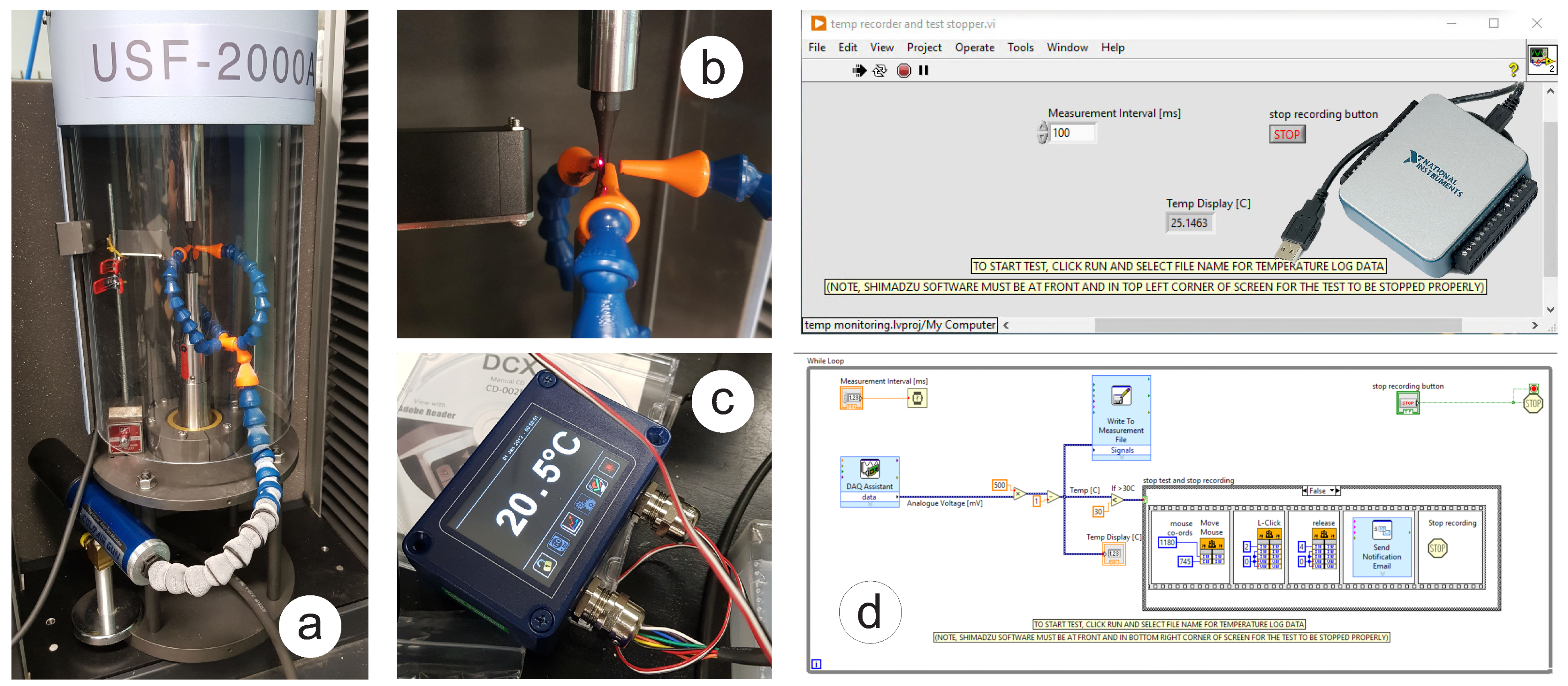


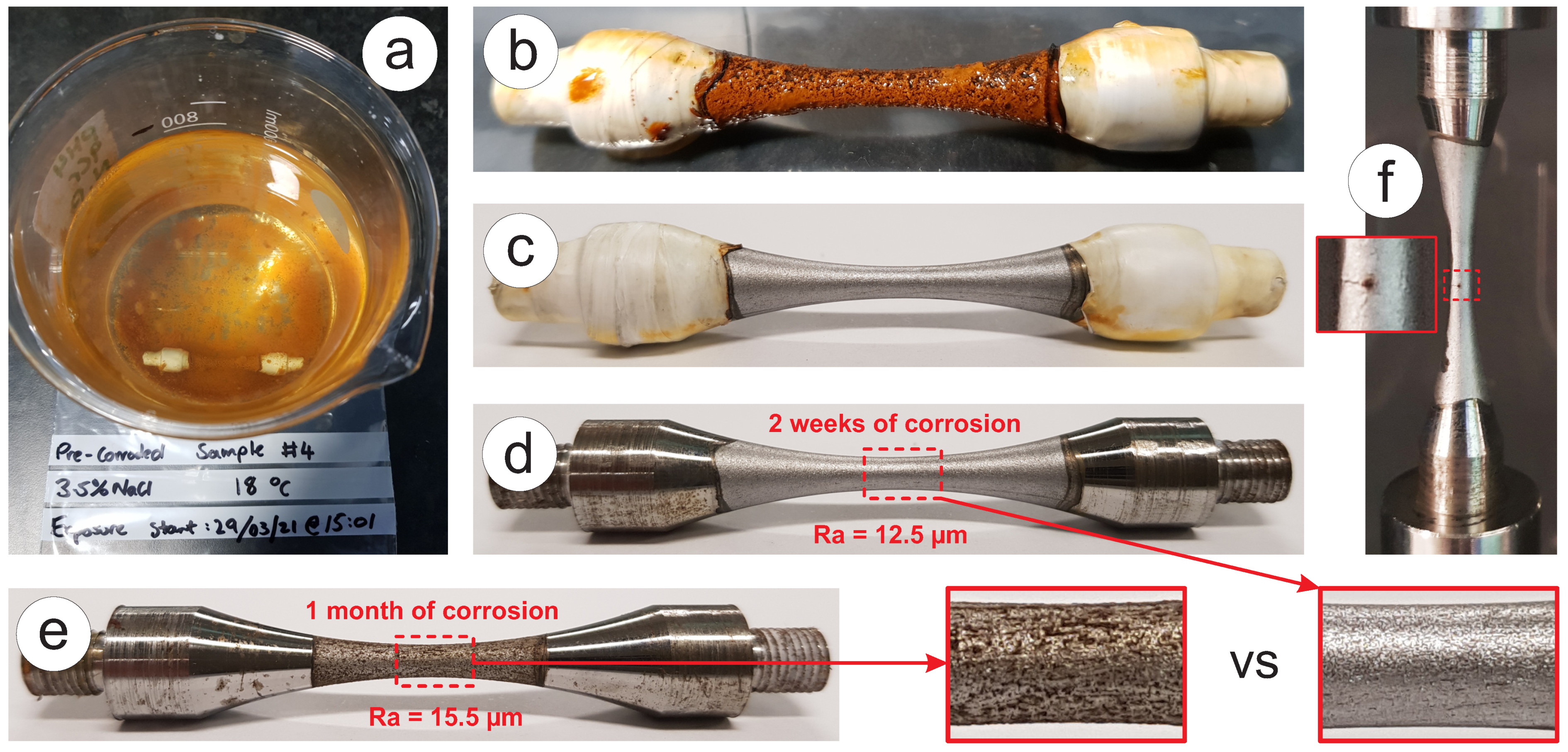
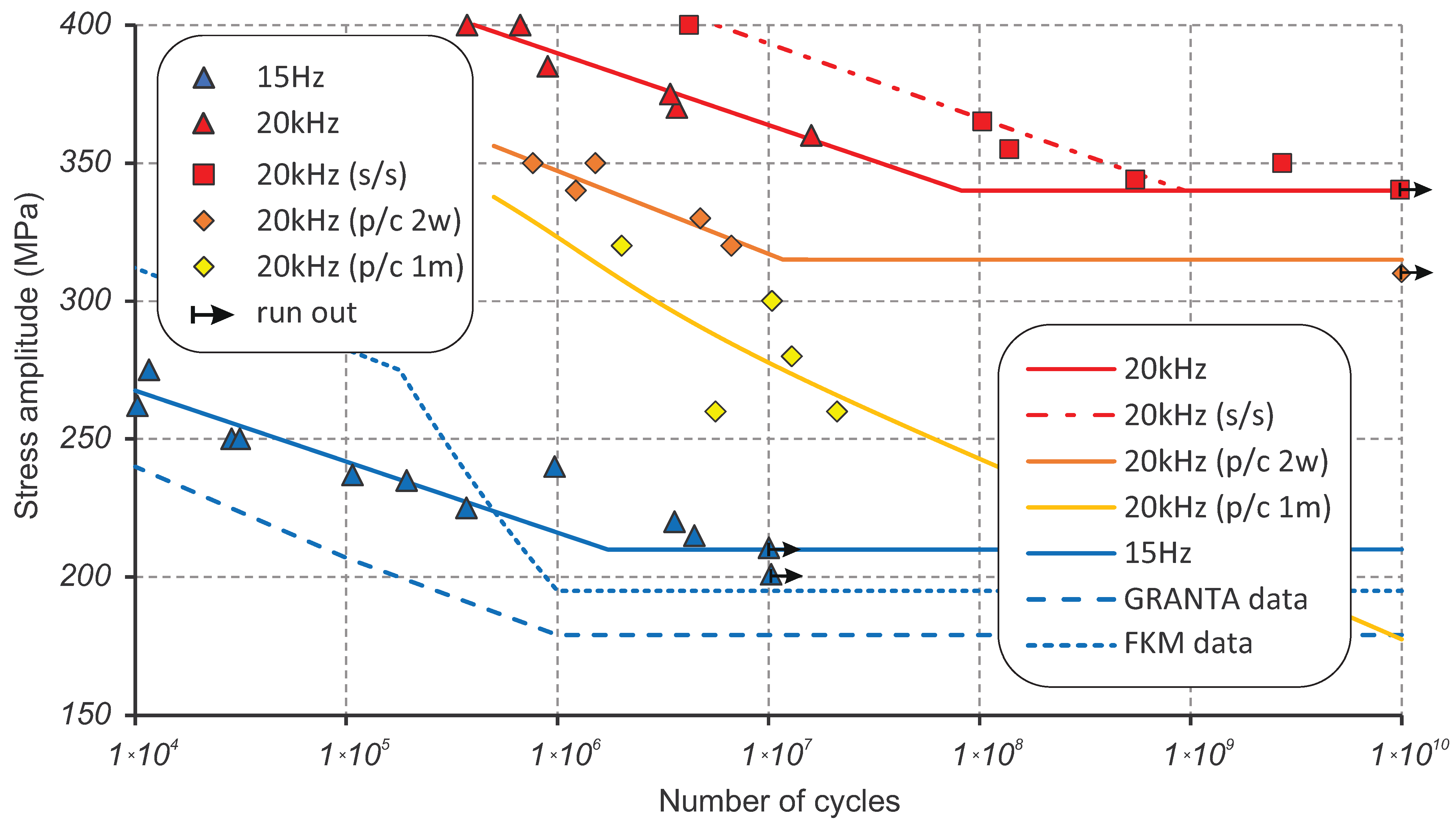



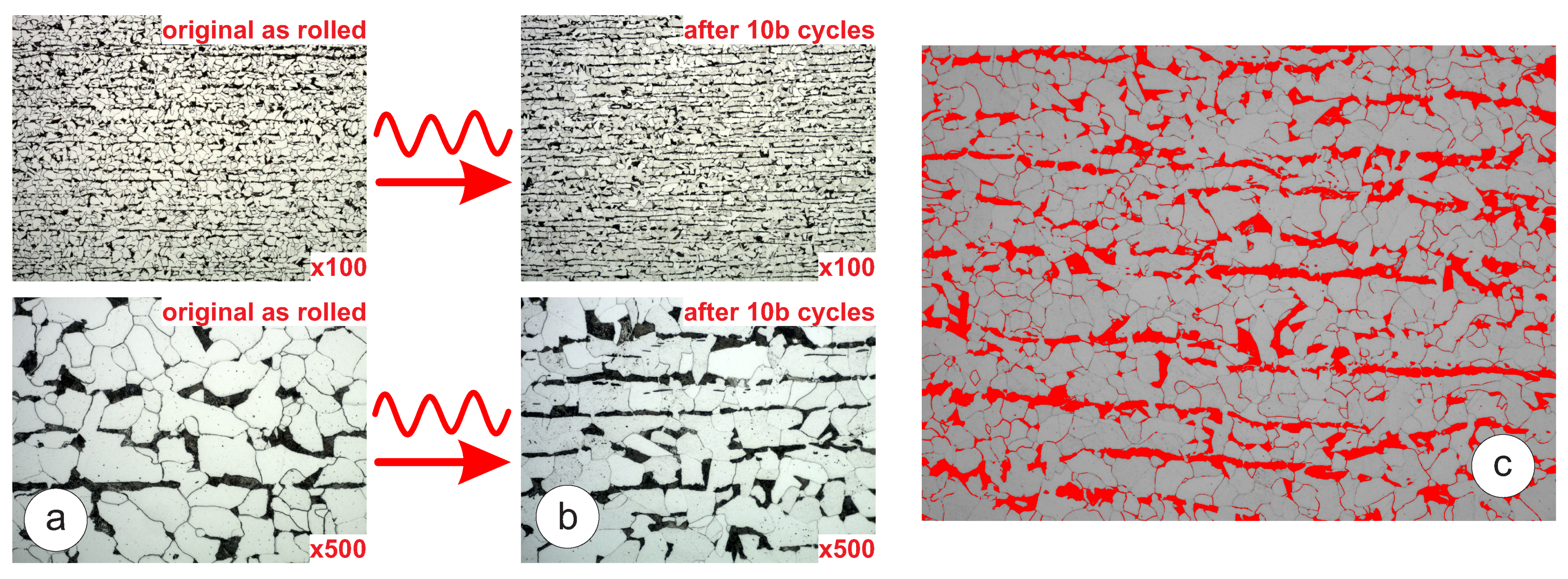
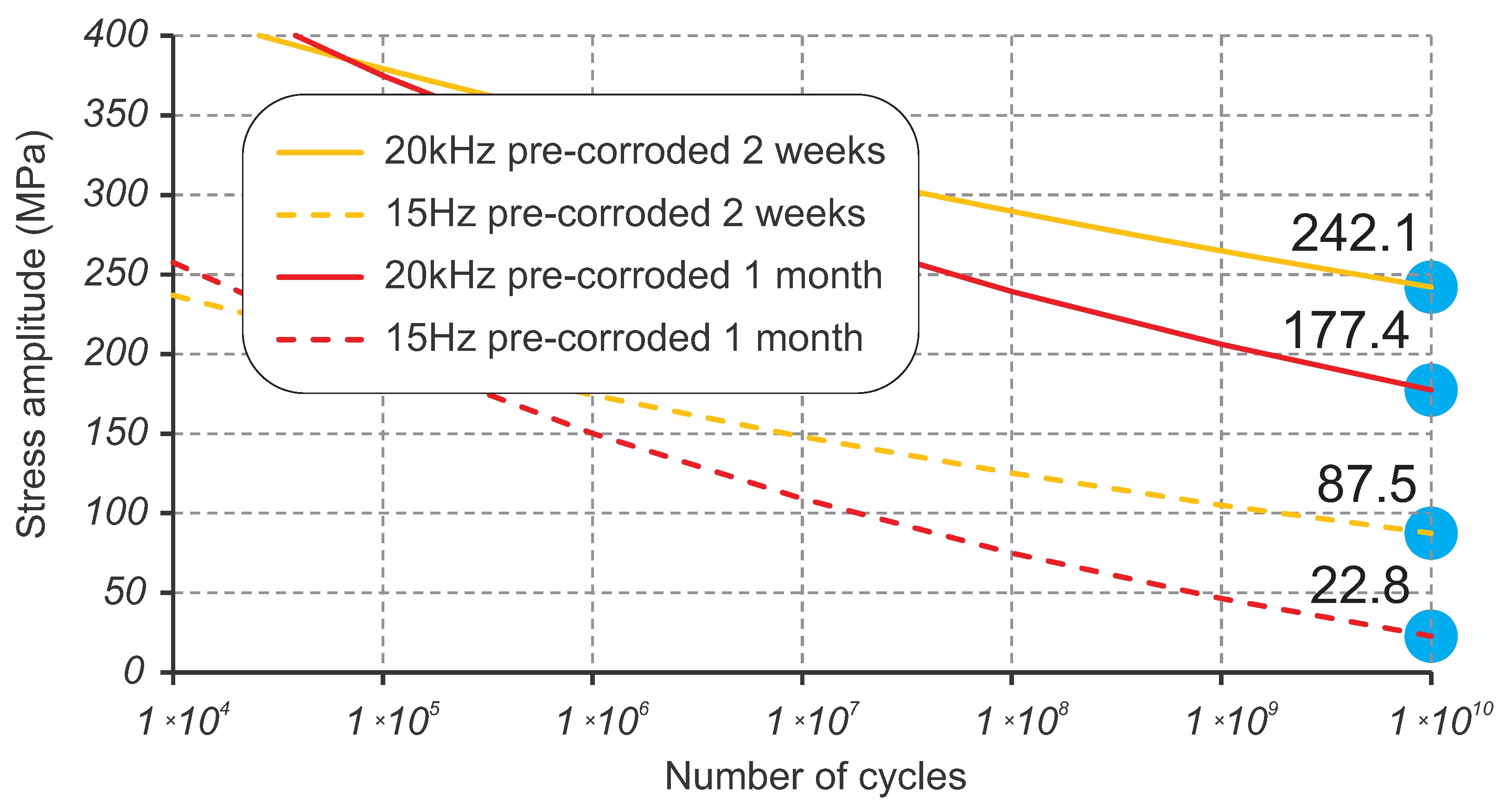
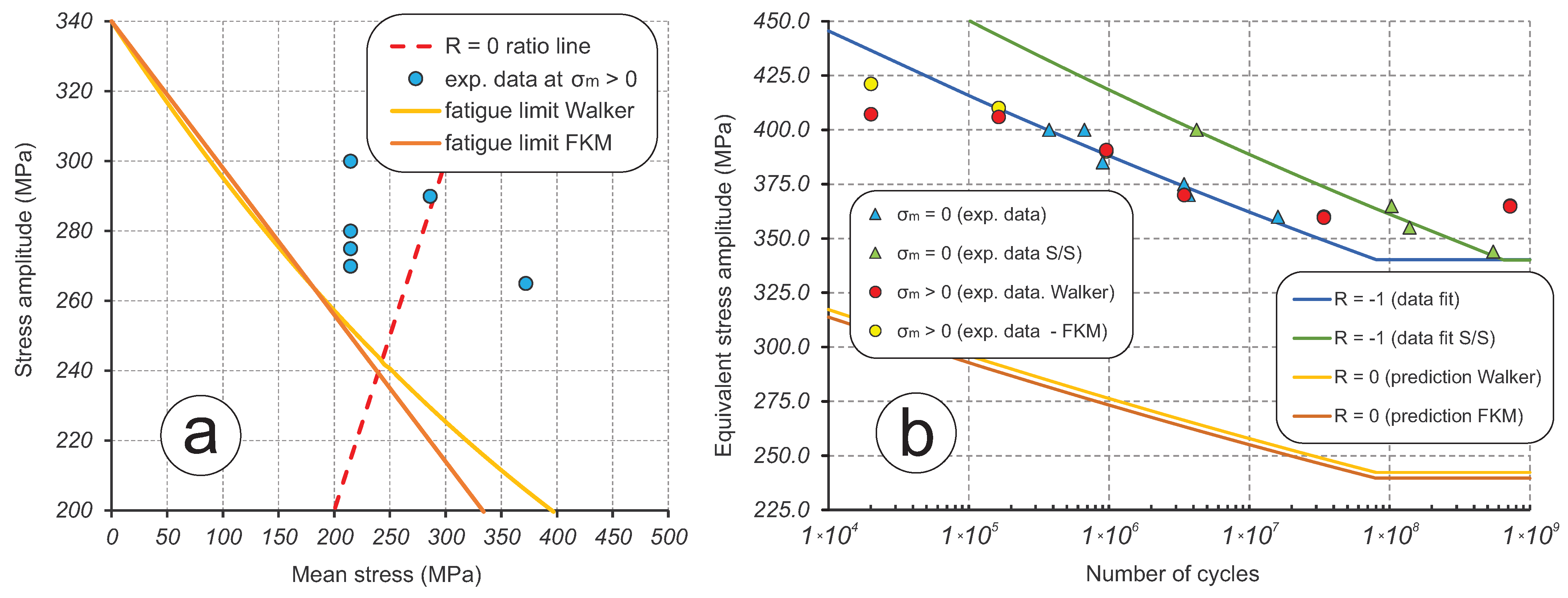
| Young’s Modulus [GPa] | 0.2% Proof Stress [MPa] | Tensile Strength [MPa] | Elongation at Break [%] |
|---|---|---|---|
| 211.1 (210 ‡) | 314 (338 */275 †) | 468.9 (469 */410 †) | 31.8 (30.5 */23 †) |
| Groups | 0 | 1 | 2 | 3 | 4 |
|---|---|---|---|---|---|
| Parameters | 15 Hz eq.fit | 20 kHz eq.fit | 20 kHz (s/s) eq.fit | 20 kHz (p/c 2w) eq.fit | 20 kHz (p/c 1m) eq.fit |
| b | −0.047 | −0.03 | −0.031 | −0.039 | −0.065 |
| 426.15 | 599.71 | 659.12 | 610.56 | 829.06 | |
| 0.92 | 0.93 | 0.98 | 0.84 | 0.44 |
Disclaimer/Publisher’s Note: The statements, opinions and data contained in all publications are solely those of the individual author(s) and contributor(s) and not of MDPI and/or the editor(s). MDPI and/or the editor(s) disclaim responsibility for any injury to people or property resulting from any ideas, methods, instructions or products referred to in the content. |
© 2023 by the authors. Licensee MDPI, Basel, Switzerland. This article is an open access article distributed under the terms and conditions of the Creative Commons Attribution (CC BY) license (https://creativecommons.org/licenses/by/4.0/).
Share and Cite
Gorash, Y.; Comlekci, T.; Styger, G.; Kelly, J.; Brownlie, F.; Milne, L. Ultrasonic Fatigue Testing of Structural Steel S275JR+AR with Insights into Corrosion, Mean Stress and Frequency Effects. Materials 2023, 16, 1799. https://doi.org/10.3390/ma16051799
Gorash Y, Comlekci T, Styger G, Kelly J, Brownlie F, Milne L. Ultrasonic Fatigue Testing of Structural Steel S275JR+AR with Insights into Corrosion, Mean Stress and Frequency Effects. Materials. 2023; 16(5):1799. https://doi.org/10.3390/ma16051799
Chicago/Turabian StyleGorash, Yevgen, Tugrul Comlekci, Gary Styger, James Kelly, Frazer Brownlie, and Lewis Milne. 2023. "Ultrasonic Fatigue Testing of Structural Steel S275JR+AR with Insights into Corrosion, Mean Stress and Frequency Effects" Materials 16, no. 5: 1799. https://doi.org/10.3390/ma16051799
APA StyleGorash, Y., Comlekci, T., Styger, G., Kelly, J., Brownlie, F., & Milne, L. (2023). Ultrasonic Fatigue Testing of Structural Steel S275JR+AR with Insights into Corrosion, Mean Stress and Frequency Effects. Materials, 16(5), 1799. https://doi.org/10.3390/ma16051799






